
LAMBORGHINI Gallardo
Generations Timeline, Specs and Pictures

The new Gallardo Squadra Corse is derived directly from the race car.
Both share the same V10 engine, which is used in the racing version with no modifications. Likewise, the Squadra Corse has the same rear wing for greater aerodynamic load - achieving, under the best aerodynamic conditions, three times the load of the Gallardo LP 560-4 - for increased dynamic stability during tight high-speed cornering. Another element taken directly from the racing version is the removable engine hood equipped with a quick-release system. Both the rear wing and the hood are made from carbon composite material, as are a host of other components on the Squadra Corse.
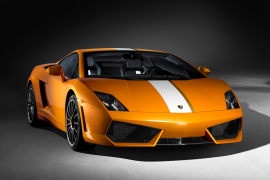
As a retirement gift for its chief test-driver Valentino Balboni, Lamborghini built a special edition for the Gallardo.
It was the only RWD vehicle in its lineup: the Gallardo 550-2 VB.
Usually, when a top-manager retires, the company gives him a golden watch, or a car, or something to remember them about the company they worked for. Lamborghini did something special: they built a special car so the customers will remember a test-driver. He test drove the Lamborghini cars for more than four decades and it was retired due to changes in Italian legislation in 2008.
The Gallardo LP550-2 VB featured few distinctive elements on its bodywork to differentiate it from its brothers. Though, it was like the black stallion with a star on its forehead. The white and gold line across the top of the car made the biggest visual difference. When it was parked, the 550-2 badge mounted low on the side sills, in front of the rear wheels, could tell the difference to a trained eye.
Inside, there was the same interior as any other Lamborghini Gallardo except for a few details. The interior was upholstered in black leather for the seats with a white stripe on the back. The center console was covered in Polar white leather, and below the left side window, there was an aluminum badge with the signature of Valentino Balboni and the production number of the car.
The drivetrain was tuned to Valentino Balboni’s taste. For starters, the LP550-2 was the first rear-wheel-drive Lamborghini in over a decade. The base version was fitted with a 6-speed manual transmission with an option for a 6-speed automatic. The suspension and the differential were different than the rest of the Gallardo range. Only 250 units were made.
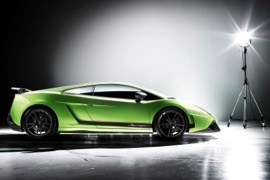
At the 2010 Geneva Motor Show, Lamborghini showed the second generation of the Lamborghini Gallardo Superleggera 570-4.
As its name suggests, it is the lightened version of the Lamborghini Gallardo supercar. But there is more about the car than just the 70 kg (154 lbs) weight loss. The Superleggera stole the hearts (and budgets) of those who were looking for a track car able to drive on the road.
Lamborghini engineers put the car on a diet. They changed the door panels, side and rear window, took away most of the soundproofing and even changed the interior. The seats are lighter and slimmer than those from a regular Gallardo. The center tunnel and dashboard are covered into a thin, light material. They even replaced the spoiler with a lighter one. But this is not all that they did for the Superleggera.
Once on the track, the owner will thank the engineers for installing a six-point harness, which will keep them fixed on the seats. Then, it’s the suspension that is changed. The wheels are different and the tires are semi-slicks. Of course, if the track rules allow, these can be replaced with track-oriented slick tires.
Performance is better than that of a regular Gallardo. And it is not just the 3.4 seconds needed for the 0 to 100 kph (0-62 mph) sprint. It is the cornering behavior and the music from the V10 behind the cockpit that can be heard better. Yes, it does have a radio, but who cares?
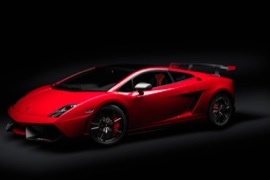
The Lamborghini Gallardo LP570-4 Super Trofeo Stradale is probably the most extreme Galardo ever made by the Italian car manufacturer.
Based on the successful Lamborghini Blancpain Super Trofeo race car, the LP570- will be produced in a limited 150 units production. It shares the same V10 engine with the original race car, and the similarities don’t stop here. The Super Trofeo Stradale features a quick-release engine hood system, carbon composite material spoiler and hood and lots of aluminum and carbon fiber parts in its construction, having a total weight of 1340 kg (2954 lb). The 2.35 kh/hp (5.2 lb/hp) power to weight ratio, enables the car to accelerate from 0 to 100 km/h (62 mph) in fust 3.4 seconds, while achieving a top speed of 320 km/h (199 mph), thanks to an all-wheel drive system using a robotized six-speed gearbox. Other features include a high performance suspension and braking systems and a “Roso Mars” exterior and interior finish. Also the cabin uses a sporty minimalist design, wrapped in Alcantara and carbon fiber materials.

The first Lamborghini created entirely under the Audi management had the 560-4 variant launched in 2012 and it was an evolution hidden under a similar look with its predecessor.
For a long period of time, Lamborghini built only extreme supercars that couldn’t be driven on a day-to-day basis. None of them were like the Porsche Turbo or like some Ferraris. After a “relaxed” drive into a Countach or a Diablo, some aspirins were needed. But the Gallardo was different. It was an easy to drive vehicle and it could run very fast on roads and tracks. This is one of the reasons why it was the most successful model in Lamborghini history, with the most sales. And there was a big number of clients who ordered it with the 6-speed dual-clutch automatic transmission.
The 2012 model featured a new, nicer interior. And, since the Audi switched most of its cars to the Audi Virtual Cockpit, the round dials on the instrument cluster in the Gallardo were something different. The details, the optional Alcantara-wrapped dashboard, and the new infotainment system made an easier life on board of the 2012 Gallardo.
For the performance management, the older 5.0-liter V10 was thrown away and a new, 5.2-liter unit was dropped-in. It wasn’t just a bigger displacement for the old engine. Even the firing order of the cylinder was different. A new direct-fuel injection system was adopted and, when all the added features combined, the final results were better than those obtained a few years ago by the stripped out 2010 Gallardo Superleggera.
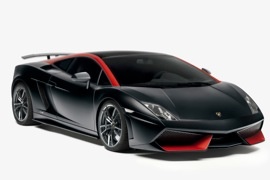
The Gallardo was the best selling Lamborghini in history and, between 2003 and 2012 it was sold in more than 13.000 units. In 2012, toward the end of its career, the Italian car-manufacturer unveiled the “Edizione Technica”.
Lamborghini succeeded to take more money from its customers with special editions along the production time of the Gallardo. Either it was the Superleggera, the Valentino Balboni, Bicolore, or Gold Edition, it found a way to make new special models of, basically, the same car, with rear or all-wheel-drive. Some of the special models had nothing important to offer, other than a two-paint job or special paint and some decals on the outside. The Superleggera was lighter and offered better performances with a sacrifice for the occupant’s comfort. And then it was the “Edizione Technica” (Technical Edition) 570-4.
Every special edition of a Lamborghini had to show that on the outside and that was the same with the Edizione Technica. It featured a fixed-wing in the back and special colors on the outside. There were three exclusive optional color combinations, with the roof and the front air intakes painted in a contrast color to the rest of the car.
For the technical point of view, the car was featured carbo-ceramic brakes, which combine low weight and better fade resistance than the regular, steel-brakes.
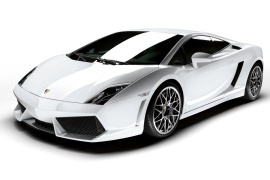
While the 2008 world financial crisis started to spread globally, Lamborghini dared to introduce a refreshed version of its two-year-old Gallardo.
The baby-Lambo was a better choice to save the company than the more expensive models, and the company’s management placed their bets on it. Fortunately, thanks to Audi’s backup and Volkswagen’s money, the Italian brand survived.
It takes a keen eye to distinguish the 2006 Gallardo from a 2008 model year. Both featured wedged shapes with angular headlights. The main difference was that on the ‘08 model, its headlamps were shorter. Moreover, at the front, the new model featured enhanced side air-scoops in the front bumper. In the back, the 2008 Gallardo sported new taillights. They were still squared but stretched over the upper panel.
Inside, Lamborghini tried hard to hide its links with Audi by installing a new design for most of the buttons. Yet, a few left remembered us that somewhere behind the raging bull was a humble A3 TDI with the same switches. But the seats were gorgeous, with high-bolstered areas to keep their occupants fixed during complex cornering maneuvers. Lamborghini placed a straight, polished gear stick poking out from the center console for the manual version. In contrast, the automatic version installed three buttons on a round aluminum disc plus two paddle-shifters behind the steering wheel.
Under the hood, the Italian carmaker used a re-tuned version of Audi’s 5.2-liter V-10 engine. Its power increased to 560 hp and sent it in all corners.
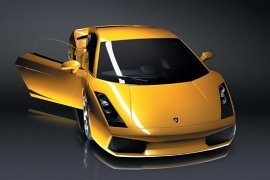
Lamborghini introduced the Gallardo at the 2003 Geneva Motor Show and represented the Italian supercar manufacturer’s new entry-level range.
After Audi purchased it, Lamborghini started to work on a new lineup. With some help from German engineers and ItalDesign Giugiaro’s design, the final result was a stunning-looking car powered by a completely new V10 engine. The Italian brand was back on track.
Short, flat, and wedged-shaped, the Gallardo kept the Lamborghini design language alive. Its long, angular headlights and short front were followed by an arched greenhouse and a flat engine lid in the back with vents. Its wide rear fenders featured massive air-intakes to cool and feed the engine. In the back, the design team returned to the angular shapes and installed vertical, squared-looking taillights. The dual exhaust popped through the rear bumper above the splitter.
Inside, the Gallardo was cramped and fit for two occupants, separated by a massive center console. The leather-clad interior was better finished than some of the other Lamborghini vehicles before the Audi-era, but some Audi A3 buttons and switches spoiled the exclusive car’s look. Depending on the version, the car featured buttons for the automatic transmission selector or a short gear-stick.
Under the hood, Lamborghini dropped a 5.0-liter naturally aspirated screaming engine that could rev up to 8050 rpm while its peak power was provided at 7.800 rpm. Thanks to its all-wheel-drive system, the Gallardo promised to be a daily-driver supercar and directly attacked the Ferrari F360 and Porsche 911 Turbo customers.
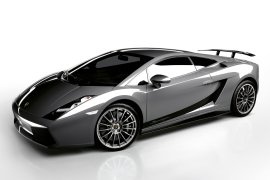
In Italian “superleggera” means “superlight” and the Gallardo Supperleggera struggled to achieve exactly that.
With a loss of some 70 kg (154 lb) this model uses carbon fibre body panels, rear difuser, undertray and rearview-mirror housings. On the inside, one can find carbon fibre on the interior door panels, the cetral tunnel and the engine cover. With a drop in weight came an increase in power, as the car received 10 more horsepower giving it a grand total of 530. This shaved 01 seconds off the acceleration time of the base Gallarado which could now do 0 to 63 mph in 3.8 seconds.

The Gallardo was on the market for two years already, and the customers already asked for something more, and Lamborghini said yes.
As part of the Volkswagen Group (Audi’s, actually), Lamborghini tried to please its customers. The Gallardo was an excellent start, especially for those who bought one but never had an Audi in their entire life. But those who had an A8 or were driven into the German all-wheel-drive limousine were not that happy that their exclusive supercar shares the same buttons with a regular car. Lamborghini couldn’t do much about that, but at least it tried when it introduced the Gallardo SE in 2005.
There were just a few clues that showed the differences between the initial series and the 2005 Special Edition. For starters, the car sported a black top, apart from the front trunk lid. Its roof and the engine cover, apart from the polycarbonate area, were painted shiny black. But that was not enough for its customers. Lamborghini moved over and upgraded the interior with a suede-covered steering wheel with paddle-shifters behind it.
For the drivetrain, Lamborghini tuned the engine and squeezed ten more ponies from the five-liter engine, and brought it to a total of 520 hp. A re-tuned suspension, shortened gearing, and new Pirelli P-Zero Corsa transformed the car into a much better racing weapon than its regular, less-powered sibling.























































